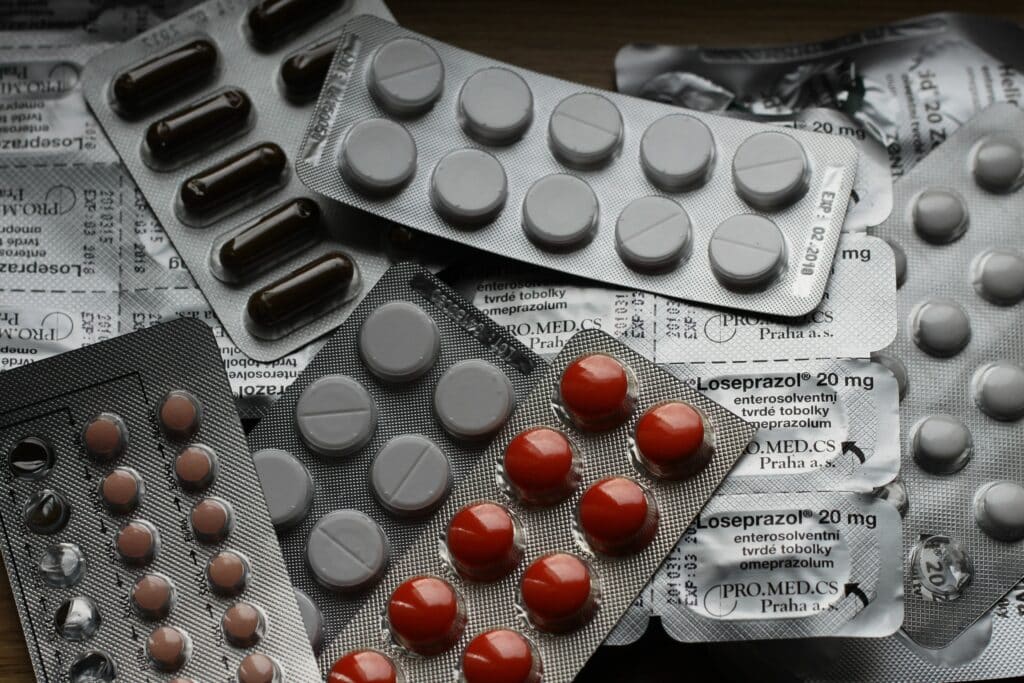Prescription medications can be highly effective if they are used exactly as directed. Are prescription pills addictive, though? Unfortunately, if these controlled substances are abused, this increases the risk of dangers including addiction and life-threatening overdose. Today’s guide highlights the most addictive medications prescribed by physicians in the United States.
What are Addictive Medications?
Most addictive medication is only available with a supporting prescription.
Need help getting addiction treatment?
Addictive medicines cause tolerance to build. As the effects of the medication diminish, many people use more of the addictive pills to achieve the same effects. Abusing medications in this way accelerates the development of physical dependence.
When you are physically dependent on a drug, you require the substance in order to function normally. In its absence, adverse withdrawal symptoms will manifest. Addiction often but not always follows. Tolerance and withdrawal are both diagnostic criteria for addiction, clinically described as substance use disorder.
Substance use disorders are diagnosed as mild, moderate, or severe depending on the number of symptoms present. Symptoms are outlined in DSM-5-TR, the most recent edition of APA’s Diagnostic and Statistical Manual of Mental Disorders).
According to the most recent data from SAMHSA (Substance Abuse and Mental Health Services Administration), over 16 million U.S. adults misused prescription psychotherapeutics in 2020. Among these:
- 9.25 million people misused prescription painkillers.
- 5.5 million people misused prescription tranquilizers.
- 1.2 million people misused prescription sedatives.
- 4.8 million people misused benzodiazepines.
- 3.4 million people were diagnosed with substance use disorders involving prescription medications.
NIDA (National Institute on Drug Abuse) defines addiction as a chronic brain disease characterized by relapse and the compulsive use of addictive meds or illicit narcotics despite obviously negative outcomes.
Some prescription medications have a more pronounced profile for abuse and addiction. Addictive drugs have one commonality regardless of whether they are illegal narcotics like heroin and cocaine, or medications prescribed by a doctor – they impact the reward system of the brain by increasing production of dopamine. Dopamine is a neurotransmitter (chemical messenger in the brain).
Most Addictive Medications
The symptoms of prescription medication abuse and addiction vary according to the medication.
These are the most addictive prescription drugs:
- Opioids
- Opioid Addiction Medications
- CNS Depressants
- Z-Drugs
- Stimulants (ADHD Medications)
1) Opioids
Opioids are the most abused of all prescription medications in the United States.
This class of medication has potent painkilling properties. Additionally, opioid-based painkillers also trigger a sense of relaxation and euphoria. A desire to recreate this euphoria, alongside the inherently addictive nature of opioids, means that many people rapidly become trapped in a vicious cycle of ongoing abuse and addiction.
Some common prescription opioids include:
- Hydrocodone (Lortab)
- Oxycodone (Percocet)
- Codeine
- Codeine/acetaminophen
- Tramadol
- Fentanyl
All of the above medications are controlled substances with a strong potential for addiction.
Opioids were traditionally prescribed for the relief of pain in patients with terminal illnesses – late-stage cancers, for example. Toward the turn of the millennium, pharmaceutical companies aggressively marketed opioids as non-addictive medications suitable for the treatment of chronic pain. These claims were proved false, and an opioid epidemic unfolded across the United States. This crisis remains unresolved in 2022.
If you are addicted to opioids, the following withdrawal symptoms will manifest when you discontinue use:
- Agitation
- Irritability
- Cravings
- Runny nose
- Insomnia
- Chills
- Excessive sweating
- Digestive problems
Detoxing from opioids can be dangerous and potentially deadly. Engaging with a supervised medical detox will streamline withdrawal and mitigate complications.

2) Opioid Addiction Medications
Methadone is one of three medications approved by the FDA (U.S. Food and Drug Administration) for the treatment of opioid use disorder.
While methadone can be highly effective for encouraging ongoing abstinence from opioids, this powerful opioid can also be highly addictive.
Methadone is a synthetic opioid agonist that acts on the same receptors as other opioids like heroin or morphine. Methadone achieves this without producing strong euphoric effects.
Nevertheless, methadone can trigger mild euphoria. In high doses, these euphoric effects are intensified.
When used in a controlled setting as part of a comprehensive opioid addiction treatment program, though, methadone is typically considered safe and effective.
3) CNS Depressants
CNS depressants work on the central nervous system, inducing a calming effect. These medications are also known as tranquilizers.
The most abused central nervous system depressants are:
- Benzodiazepines
- Barbiturates
Common indicators of misuse include:
- Confusion
- Irritability
- Lethargy
- Drowsiness
- Memory loss
- Headaches
- Dizziness
- Slurred speech
- Nausea and vomiting
- Changes to personality or behavior
Xanax, a branded version of alprazolam, is the most abused benzodiazepine.
Prescribed to treat panic disorders and anxiety disorders, Xanax is effective if used short-term. The sustained use of benzodiazepines causes tolerance and physical dependence to form, often followed by addiction.
From 1998 to 2008, the number of U.S. adults seeking treatment for addiction to benzos tripled.
Abusing benzos can interfere with these processes and functions:
- Memory
- Thought processes
- Emotional response
- Consciousness
- Muscular coordination
Addiction to Xanax is associated with many negative health outcomes, including a heightened risk of Alzheimer’s disease.
Benzodiazepine withdrawal can be dangerous, possibly leading to a fatal coma. A tapered withdrawal in a licensed medical detox center will mitigate the dangers of benzo detox.
4) Z-Drugs
Z-drugs belong to the sedative-hypnotic class of drugs. The most common Z-drugs are:
- Zolpidem (Ambien)
- Zopiclone (Zimovane)
- Zaleplon (Sonata)
These medications have a mechanism of action that works on a neurotransmitter called GABA (gamma aminobutyric acid). GABA is a chemical messenger that slows activity in the CNS (central nervous system) and the brain. This mechanism of action is similar to that of benzos.
Although Z-drugs were marketed as a safer alternative to benzodiazepines, the risk of dependence, addiction, and withdrawal is higher than first anticipated.
Using this class of medication can cause physical dependence to develop in just two weeks, even if the medication is used as directed.
The primary adverse outcomes associated with the abuse of Z-drugs like Ambien include:
- Physical dependence
- Psychological cravings for Ambien
- Increased risk of overdose
- Withdrawal symptoms
- Addiction
If you become addicted to Z-drugs, it is advisable to engage with a supervised medical detox. A tapered withdrawal and the administration of medications can streamline Z-drug detox.
Do not attempt to stop using Z-drugs abruptly and without medical guidance. Z-drugs reduce activity in the brain and withdrawal can prompt brain activity to increase to such an extent that seizure occurs.
5) Stimulants (ADHD Medications)
Prescription stimulants are used to treat the following conditions:
- ADHD (attention deficit hyperactivity disorder)
- Narcolepsy
Is ADHD medication addictive, then?
Yes. Both Adderall (dextroamphetamine) and Ritalin (methylphenidate) can be addictive.
Prescription stimulant medications are intended to increase:
- Energy
- Alertness
- Attention
These medications deliver those effects by boosting the activity of brain chemicals like dopamine. Resultantly, stimulants deliver pleasurable and euphoric sensations that can be highly addictive.
Methylphenidate (Ritalin) stimulates the central nervous system and increases dopamine production in the brain. The long-term use of all stimulants can be strongly habit-forming.
Amphetamine (Adderall) is also a central nervous system stimulant. Amphetamine products are frequently abused for their energizing properties.
Addiction Recovery at Renaissance Recovery
Prescription medications contain many different chemicals. The dangers of misusing these medications can vary from minor discomfort to irreparable damage and addiction in the form of substance use disorder. Abusing prescription drugs can even be fatal.
If you need help addressing the physical and psychological components of addiction to prescription meds, we offer the following treatment programs here at Renaissance Recovery Center in Orange County:
- OP: traditional outpatient program
- IOP: intensive outpatient program
- Virtual IOP: remote rehab
- PHP: partial hospitalization program
We advocate a whole-body approach to recovery from addiction here at Renaissance. Access the following holistic therapies and evidence-based interventions:
- Medication-assisted treatment
- Psychotherapy (CBT or DBT)
- Individual counseling
- Group therapy
- Family therapy
- Experiential adventure therapy
Move beyond addiction to prescription medications by reaching out to Renaissance at 866.330.9449.




